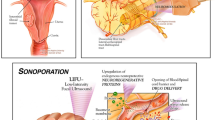Abstract
High intensity focused ultrasound (HIFU) has been used in a number of clinical studies. High intensity focused ultrasound could become the minimally invasive tumor therapy of choice if it could be used to occlude the feeding arteries of tumors by exposure from outside the body. We used high intensity focused ultrasound to insonate the femoral arteries of both thighs of 18 male and female Sprague-Dawley (SD) rats, at frequencies of 1 or 3 MHz. Duration of exposure to high intensity focused ultrasound was 5 or 10 seconds. The femoral artery that was exposed to high intensity focused ultrasound was resected immediately after or 24 hours, 48 hours, or 12 days (at 1 MHz) after insonation. Arterial blood flow occlusion was achieved at 3 MHz, but not at 1 MHz. Free-field spatial peak intensity was 800 W/cm2 at 1 MHz and 10 kW/cm2 at 3 MHz. Histologic examination of the resected specimen showed that changes varied with ultrasound frequency and time course after exposure to high intensity focused ultrasound. We suggest that high intensity focused ultrasound might prove useful in occluding arteries when treating tumors in the clinical setting.
Similar content being viewed by others
References
Wood RW, Loomis AL: The physical and biological effects of high frequency sound waves of great intensity. Phil Mag 1927;4 (7): 417–436.
Coleman DJ, Lizzi FL, Driller J, et al: Therapeutic ultrasound in the treatment of glaucoma-I experimental model.Ophthalmology 1985;92: 339–346.
Mandersbacher S, Kratzik C, Susani M, et al: Tissue ablation in benign prostatic hyperplasia with high intensity focused ultrasound.J Urol 1994;152: 1956–1961.
Gelet A, Chapelon JY, Bouvier R, et al: Treatment of prostate cancer with transrectal focused ultrasound: early clinical experience.Eur Urol 1996;29: 174–183.
Vallancien G, Harouni M, Guillonneau B, et al: Ablation of superficial bladder tumors with focused extracorporeal pyrotherapy.Urology 1996;47: 204–207.
Mulligan ED, Lynch TH, Mulvin D, et al: High intensity focused ultrasound in the treatment of benign prostatic hyperplasia. B J Urol 1997;79: 177–180.
Chapelon JY, Gelet A, Souchon R, et al: Therapy using ultrasound: application to localized prostate cancer. J Echgor Med Ultrason 1998;19: 260–264.
Uchida T, Muramoto M, Kyunou H, et al: Clinical outcome of high intensity focused ultrasound for treating benign prostatic hyperplasia: preliminary report.Urology 1998;52: 66–71.
Hynynen K, Freund WR, Cline HE, et al: A clinical, noninvasive, MR-imaging monitored ultrasound surgery method.Radiographics 1996;16: 185–195.
Delon-Martin C, Vogt C, Chignier E, et al: Venous thrombosis generation by means of high intensity focused ultrasound.Ultrasound Med Biol 1995; 21: 113–119.
Hynynen K, Colucci V, Chung A, et al: Noninvasive arterial occlusion using MRI-guided focused ultrasound.Ultrasound Med Biol 1996;22: 1071–1077.
Rowland IJ, Rivens I, Chen L, et al: MRI study of hepatic tumors following high intensity focused ultrasound surgery.Br J Radio 1997;70: 144–153.
Rivens I, Rowland I, Denbow M, et al: Focused ultrasound surgery induced vascular occlusion in fetal medicine. Int Proc SPIE, 1998;3249: 260–265.
Vaezy S, Martin R, Schmiedl U, et al: Liver hemostasis using high intensity focused ultrasound.Ultrasound Med Biol 1997;23: 1413–1420.
ter Haar G: Thrapeutic ultrasound.Eur J Ultrasound 1999;9: 3–9.
Summer W, Patrick MK:Ultrasonic Therapy: A Textbook for Phisiotherapists. London, Elsevier, 1964.
Chapman IV, Macnally NA, Tucker S: Ultrasound induced changes in rates of influx and efflux of potassium ions in rat thymocytes in vitro.Ultrasound Med Biol 1979;6: 47–58.
Mortimer AJ, Dyson M: The effect of therapeutic ultrasound on calcium uptake in fibroblasts.Ultrasound Med Biol 1988;71: 66–70.
Author information
Authors and Affiliations
About this article
Cite this article
Fujiwara, R., Sasaki, K., Ishikawa, T. et al. Arterial blood flow occlusion by high intensity focused ultrasound and histologic evaluation of its effect on arteries and surrounding tissues. J Med Ultrasonics 29, 85–90 (2002). https://doi.org/10.1007/BF02481229
Received:
Revised:
Issue Date:
DOI: https://doi.org/10.1007/BF02481229




